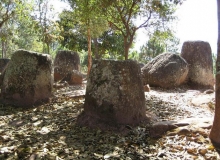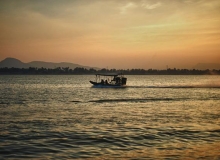
Speak to a specialist
0208 777 4873
0208 777 4873
Places To See: Laos
VIENTIANE
Set along a bend in the Mekong River, Laos' capital is a relaxing place to while away a few days. You'll find some beautiful old Wats to explore, a large market that holds the best selection of handwoven textiles in the country, a variety of good restaurants serving an international mix of cuisine, and pleasant riverside bars at which to sip a beer and enjoy the sunset. This is a lovely spot to recover from the rigors of travel.
LUANG PRABANG
The site of Laos' former royal capital, the little town of Luang Prabang is a gem. Nestled in an elbow of the Mekong surrounded by treed mountains, this remote northern town has long been Laos' religious centre. You'll find dozens of historic temples, lovely French-built villas, and streets lined with charming old shop-houses. With its main hall inlaid with a dazzling mosaic of cut glass the Royal Palace is well worth a visit, as are the Pak Ou caves, a Buddhist cave shrine some distance up river. An early wake up to enjoy giving Alm Bowl to the monks on the street for making a merit.
XIENGKHOANG - PLAIN OF JARS:
While there are many theories, nobody really knows why hundreds of huge stone jars are scattered across several sites on a barren Laotian plain. Carved from solid rock, most of these containers weigh from 600kg to one tonne apiece; the largest weighs six tonnes. The jars are said to be 2,000 years old but again, nobody knows for sure. Were they sarcophagi, water jars, rice stores' Scientists continue to debate this intriguing find; other visitors just marvel at these mysterious relics.
PAKSE
Set on the Mekong River, the southern town of Pakse features French colonial architecture and a colourful market stocked with fresh produce grown in the nearby Bolaven Plateau, a highland region inhabited by a number of ethnic minority groups. Pakse is also the jumping off point for a visit to Wat Phu, an exquisite, Angkor-era temple complex built between the 6th and 13th centuries. Even the most temple-weary visitor can't help but be captivated by the mesmerising beauty of these lonely ruins

XIENGKHOANG - PLAIN OF JARS
While there are many theories, nobody really knows why hundreds of huge stone jars are scattered across several sites on a barren Laotian plain. Carved from solid rock, most of these containers weigh from 600kg to one tonne apiece; the largest weighs six tonnes. The jars are said to be 2,000 years old but again, nobody knows for sure. Were they sarcophagi, water jars, rice stores' Scientists continue to debate this intriguing find; other visitors just marvel at these mysterious relics.

PAKSE
Set on the Mekong River, the southern town of Pakse features French colonial architecture and a colourful market stocked with fresh produce grown in the nearby Bolaven Plateau, a highland region inhabited by a number of ethnic minority groups. Pakse is also the jumping off point for a visit to Wat Phu, an exquisite, Angkor-era temple complex built between the 6th and 13th centuries. Even the most temple-weary visitor can't help but be captivated by the mesmerising beauty of these lonely ruins
Subscribe here to our monthly newsletters


